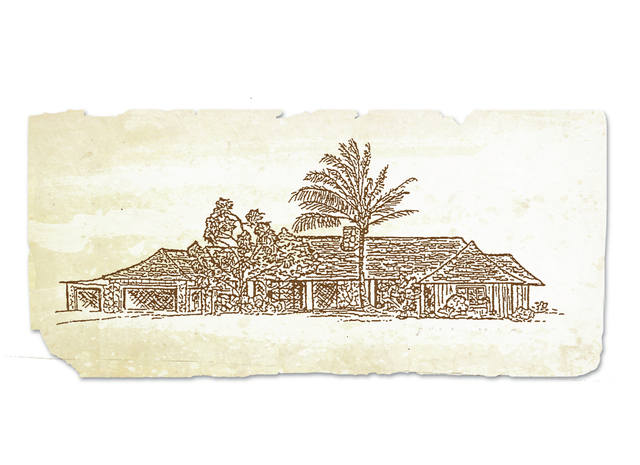Kailua’s Boettcher Estate was wealthy clan’s escape
There is an 80-year-old treasure of a public building on Kailua Beach that has largely been ignored for about a decade. It is the Ossipoff-designed residence of the Boettcher Estate that sits in the middle of what became Kalama Beach Park when the city bought the property from Mae Boettcher in 1978 for $1.5 million — about half the appraised value.
It has always been a question of why in 1935 a fabulously wealthy Denver family bought 4 acres of prime land on Kailua Beach that spans the distance between North Kalaheo Avenue and the beach. Sure, the family could afford the $16,000 it paid for the sizable piece of property, but it may have been prompted in part by a traumatic family event in 1933.
To better understand how it came about, one needs to go back to 1869, when a 17-year-old German immigrant named Charles Boettcher first landed in Wyoming to work in his older brother’s hardware store, and shortly thereafter made his way to the foothills of Colorado.
It turned out that Boettcher was a business genius. He was great at selling hardware, expanding from Boulder to Denver and then to Leadville to take advantage of the silver boom. But while the prospectors at the time were climbing all over themselves up in the Colorado mountains to scrape up silver nuggets, Charles realized he could make much more money and take little risk by selling the miners blasting powder and the accompanying mining hardware, much of which he was manufacturing himself. He did that and that began his fortune.
When silver went bust, Charles came back to Denver with lots of cash. Later on, after a trip back to his native Germany, he discovered sugar beets. The story is he made his wife leave behind piles of her clothing so he could bring back her steamer trunks full of sugar beets and seeds. That crop flourished on the flat plains of eastern Colorado. Thus he created Great Western Sugar and another fortune came along.
When he started to build a huge sugar beet processing plant, he discovered the cement came from Europe. Ever the entrepreneur, he asked why, with all the ingredients at hand in Colorado, he couldn’t make his own cement. Thus was born Ideal Cement Co., which became one of the biggest cement companies west of the Mississippi.
As Charles expanded into such areas as electricity production and investment banking, he brought his son, Claude, along as a partner. Together they kept building the family’s fortunes during most of the 20th century. They were also incredibly generous, starting the Boettcher Foundation in 1937, which exists to this day, giving away millions of dollars to worthy Colorado causes.
It was an incident with Claude’s son, Charles II (the adult grandson of the original Charles), that changed the family forever. In 1933, Charles II and his wife were returning from an evening of dining out when a car pulled into the driveway of their mansion behind them. Three members of the lowlife kidnapped Charles II at gunpoint. The ransom was $60,000. Naturally the family paid the money, and eventually the FBI found Charles II and most of the money in North Dakota.
Needless to say, it was unsettling for everyone in the family. Apparently Charles and his wife, Mae, then started looking for a place that was far away from and far different than their surroundings in Denver. So in 1935 they found the property in Hawaii, on the beach in Kailua. It was to be their get-away-from-it-all vacation home.
Vladimir “Val” Ossipoff had just started his own practice about this time. The classic residence he designed for the Boettchers is described by Historic Hawai‘i: “The property has a distinctive design … one can clearly read in the house’s elegant lines the blossoming talent of a young Val Ossipoff … it is a fine example of 1930s kamaaina architectural style … and is one of the few remaining historic beach houses of this particular genre.” As a young architect, Ossipoff now had a sterling calling card.
In a major printed work about the designer, architect Dean Sakamoto says the house is quite spacious at 4,000 square feet with seven bedrooms plus living and dining rooms. Sakamoto also says the architect was “keenly attuned to the forces of nature … Ossipoff combined the entry and the lanai as the primary outdoor social space on its more tranquil leeward side.”
The good news is the building is still intact, as are many of its original details. The not-so-good news is that at 80 years old, the Boettcher Estate is deteriorating rapidly given its exposure to the constant wind and the salt air of Kailua Beach. In the 1990s, Lucille Gibson devoted a good portion of her life to the protection and preservation of the property by establishing a nonprofit called Friends of the Boettcher Estate. They held rallies, musical events, dinner parties and numerous other fundraising events, but it was never enough. After Lucille’s death in the late ’90s, this effort seemed to fizzle.
There have been a number of volunteer or pro bono efforts at preserving the place such as termite treatment, window repair and exterior painting. The city built a comfort station for park users about 10 years ago and at about the same time redid the shake roof. Mason Architects did a master plan in 1988 that called for restoration and other improvements. But the latter has never been acted on.
The city makes the house available for meetings and other activities, but it is mainly unused.
Someone said the land alone is probably worth 1,000 times the $16,000 the Boettchers paid for it in 1935.
Keep Hawaii Hawaii is a monthly column on island architec- ture and urban planning. David Cheever, owner of David Cheever Marketing, has served on the boards of the Historic Hawai‘i Foundation and the Hawaii Architectural Foundation. Send comments to keephawaiiawaii@staradvertiser.com.


